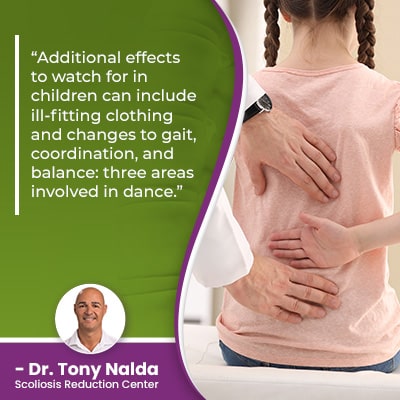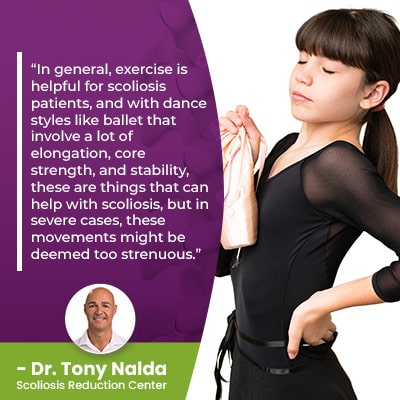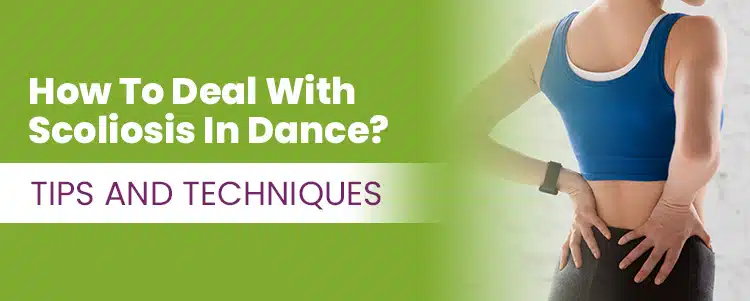There was a time when a diagnosis of scoliosis was thought to mean a life of limitation, but we’ve since learned enough about the condition, and treatment efficacy, to know that patients can still thrive. When it comes to dancing with scoliosis, there are some tips and techniques that can help ensure it’s safe for a patient.
No two cases of scoliosis are the same, and this can include activities that are deemed safe for some, but unsafe for others. A diagnosis of scoliosis doesn’t have to mean the end of a dancing career, particularly with awareness and proactive treatment.
No activity, dance included, should be attempted before it’s cleared by a patient’s treatment provider, so let’s start with why.
Understanding Scoliosis
When it comes to understanding what life with scoliosis can be like, it’s important to understand some defining condition characteristics.
Scoliosis involves the development of an unnatural sideways spinal curve that also rotates, which is why scoliosis is considered a 3-dimensional condition; a scoliotic spine doesn’t just bend unnaturally to the side, but also twists.
Scoliosis is also a progressive condition, meaning it has it in its nature to get worse over time, so where a patient’s scoliosis is at the the time of diagnosis isn’t indicative of where it will stay; only proactive treatment can work towards counteracting the condition’s progressive nature.
There are also different types of scoliosis, and the condition can affect all ages.
The most common type diagnosed is adolescent idiopathic scoliosis (AIS), diagnosed between the ages of 10 and 18, and this age group is the most at risk for rapid-phase progression because the trigger for progression is growth.
Adolescents who are in, or are entering into, the stage of puberty are going to experience rapid and unpredictable growth spurts, so the goal of treatment is to achieve a significant curvature reduction and hold it there despite the constant trigger of growth.
As adolescents are the age group most often diagnosed with scoliosis, we’ll focus on adolescents dancing with scoliosis.
Scoliosis Effects
When it comes to understanding scoliosis, its effects are important because they shape a person’s experience of life with the condition.

Scoliosis is a highly-variable condition, meaning no two cases are the same, and this is partially because it ranges so widely in severity from mild to moderate and severe to very severe.
The more severe a condition, the more out of alignment the spine is, and the more likely it is that the condition’s effects are going to be noticeable.
When scoliosis is mild, its effects can be mild and difficult to detect, particularly in children for whom the condition is not yet compressive.
Scoliosis becomes a compressive condition once skeletal maturity has been reached, which is why scoliosis is commonly diagnosed during adulthood, even though many develop scoliosis during adolescence.
In young patients who are still growing, their spines are experiencing a constant lengthening motion, and that counteracts the compressive force of an unnatural spinal curve, and it’s compression of the spine and its surrounding muscles and nerves that causes the bulk of condition-related pain.
So when a condition is mild and not painful, early detection can be a challenge.
In adults, the main effect is pain, and in children, it’s postural deviation due to the condition’s uneven forces disrupting the body’s overall symmetry.
Postural changes can include:
- Uneven shoulders
- Uneven shoulder blades
- An uneven waistline
- The development of a rib arch
- Arms and legs that appear to hang at different lengths
Additional effects to watch for in children can include ill-fitting clothing and changes to gait, coordination, and balance: three areas involved in dance.
Dance and Scoliosis
Some patients will face activity restrictions based on their condition and treatment needs, so how safe dance is for scoliosis will be case-specific.
Before we knew enough about scoliosis and treatment efficacy, living with scoliosis was thought to be very limiting, that a dance career, for example, would be over for someone diagnosed with the progressive spinal condition.
As an ancient condition, there have been a lot of years for the medical community’s understanding of scoliosis to evolve, and we can now help patients continue with many of the activities and passions they love by treating conditions proactively, customizing treatment plans, and providing lifestyle guidance to ensure activities, sports, and exercises are safe, and determining which are not.
When it comes to dance, the more severe a condition is, and the more rotation there is in the spine, the more likely it is that dance might have to be approached with caution, modification, or avoided entirely; again, each case is unique.
In general, when it comes to an activity like dance, a scoliosis diagnosis doesn’t have to mean the end of a career, but it is likely to involve approaching it differently.
I love sharing the names of famous individuals (athletes, actors, and musicians) with scoliosis with adolescent patients recently diagnosed so they can see real-time examples of people who aren’t just surviving with scoliosis, but thriving; these types of stories can be inspirational, and motivation is key to treatment success.
In all cases, dancing will need to be cleared with an adolescent’s treatment provider, and if it is, will have to be approached with caution, and for those wanting to dance professionally/competitively, extra challenges should be expected, but that doesn’t mean it can’t be done.
Let’s address some common questions parents and/or caregivers have about scoliosis and dance:
Can patients with scoliosis continue dance training?

Remember, the main condition effect in adolescents is going to be an asymmetrical body caused by the condition’s uneven forces that get worse over time, and this causes a shift in the body’s center of gravity, and related changes to balance, coordination, and gait.
If a body is asymmetrical, this also includes its muscles, and the ability to perform equal movement on both sides of the body can be difficult.
In addition, particularly when it comes to traditional dance like ballet, if the spine is bending unnaturally to the side, this means it’s being pulled, and it will take more energy and strength for that person to maintain a straight, upright, and symmetrical pose.
So dance training for adolescents with scoliosis can be more challenging, particularly when it comes to the amount of extra energy expended to maintain symmetrical movement.
In general, exercise is helpful for scoliosis patients, and with dance styles like ballet that involve a lot of elongation, core strength, and stability, these are things that can help with scoliosis, but in severe cases, these movements might be deemed too strenuous.
Elongating the spine can mean keeping it as loose and flexible as possible, and a strong core means the spine is surrounded by strong muscles capable of supporting and stabilizing it; in fact, increasing core strength is a key facet of scoliosis treatment through physical therapy and scoliosis-specific exercises (SSEs).
One of the goals of physical therapy in scoliosis treatment is to correct a scoliotic spine in 3 dimensions, one of which is elongation, and dance can help maintain spinal stability, strength, and flexibility.
Conclusion
When it comes to tips and techniques for how best to deal with scoliosis in dance, the first step is to get the type of dance cleared with a patient’s scoliosis treatment provider; if continuing with dance is deemed safe, guidance can be provided on which specific types of movements are considered safe, which should be approached with caution, and which should be avoided entirely.
When it comes to activity restrictions, these generally involve sports/activities/exercises that either overuse one side of the body, place the spine in an unnatural position, or involve repeated shocks from impact.
Activities that overuse one side of the body can exacerbate the condition’s asymmetrical effects and contribute to scoliosis-related muscle imbalance, and placing the spine in an unnatural position is exposing it to more adverse spinal tension.
Activities and movements that involve repeated shocks from impact can introduce more compression to the spine, and for adults, scoliosis is already a compressive condition, so certain dance moves that can involve jumping and landing can exacerbate this, so knowing which movements are safe, and which are not, can mean still being able to dance, just approaching it differently.
Here at the Scoliosis Reduction Center®, lifestyle guidance is part of my approach, and as it’s so important and beneficial for scoliosis patients to stay active, helping patients find a healthy activity balance that’s scoliosis-friendly is invaluable.
Dance moves that involve deep backbends and hyperextending the spine can be less than ideal for people with an unnaturally-curved spine, but in many cases, guidance and awareness is enough to make dancing a safe activity for people with scoliosis.
In addition, committing to proactive treatment is the single best way to work towards minimizing the condition’s effects, and that includes activity restrictions.




